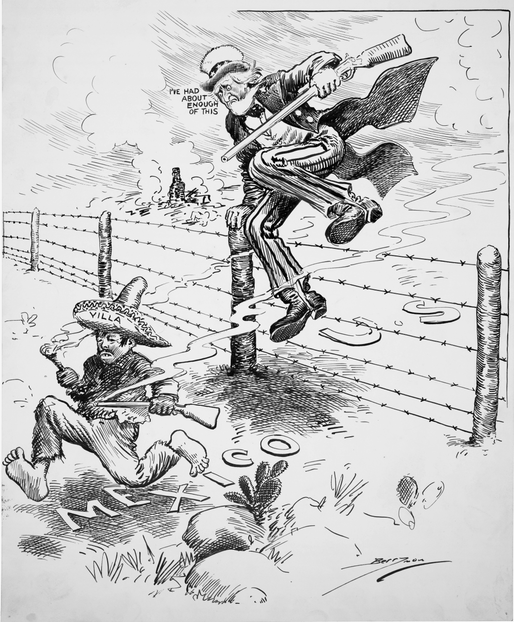Back on March 9th of 1916, General Francisco "Pancho" Villa ordered 500 to 600 troops of the Mexican Revolutionary Army of to cross the border and attack Columbus, New Mexico.
At 1:00 am, between 500 and 600 Mexican revolutionaries, led by Pancho Villa, crossed the border into the United States.
In the middle of the night, life in Columbus changed dramatically. This attack caught the entire town, as well as the U.S. Army by surprise.
They attacked a detachment of the U.S. Army 13th Cavalry Regiment, burned the town and seized 100 horses and mules, as well as other military supplies. The gunfire and burning buildings forced many Columbus residents to flee into the desert, to seek refuge in their school house, the Hoover Hotel, and take shelter in their homes.
The raiding Mexican Army did not expect the response they received from the U.S. Army. But yes, American soldiers awakened by the commotion quickly set up a Benet-Mercier machine gun in front of the Hoover Hotel and produced a murderous rain of fire on the Mexicans. Another machine gun was set up on East Boundary Street fired north and caught anyone in the intersection of Broadway and East Boundary in a deadly crossfire.
The incursion lasted until dawn, approximately two hours. The death toll totaled 70 to 75 Villistas, and eighteen Americans dead. Mostly it was American civilians who were killed.
In response to Pancho Villa's raid on Columbus, New Mexico, President Wilson sent 5,000 men of the U.S. Army under General John Pershing into Mexico to capture Villa. Our troops employed aircraft and trucks for the first time in US Army history, General "Black Jack" Pershing's force chased Villa.
And yes, while American troops were looking for Villa in Mexico, other attacks upon Americans in the United States from Mexican revolutionaries took place:
On May 15th 1916, an attack took place on Glenn Springs, Texas, killing a civilian and wounding three American soldiers.
On June 15th 1916, an attack from across the border killed four American soldiers and wounded 5 others at San Ygnacio, Texas.
On July 31st 1916, another attack from across the border killed one American soldier and a U.S. customs inspector at Fort Hancock Texas. The dead American soldier was from the 8th US Cavalry and the Customs Inspector was Robert Wood.
President Wilson was so afraid of a war with Mexico that he had imposed too many restrictions on General Pershing, this made it impossible for the General to fulfill his mission.
Take for example, the last engagement of the Mexican Expedition which was fought on June 21st when American forces were defeated by Carrancista soldiers at the Battle of Carrizal.
Captain Charles T. Boyd and ten of his men were killed with 10 wounded while 23 soldiers and 1 civilian interpreter were taken prisoner -- they were later released to the United States.
Although the Mexican commander, General Félix Uresti Gómez was killed in the action, when General Pershing learned of the battle he was furious and asked for permission to attack the Carrancista garrison of Chihuahua.
President Wilson refused because he was worried that it would lead to war. Of course, it somehow never dawned on Wilson that we were already at war. And though some of Villa's senior commanders, Colonel Candelario Cervantes, General Francisco Beltrán, Beltrán's son and Villa's second-in-command Julio Cárdenas, along with a couple of hundred Mexican revolutionaries and bandits were killed during the expedition, because of the political restraints placed on it, all in all the search for Villa was not successful.
The expedition only lasted until February 1917.
Tom Correa



Numerous would content that China has just great aims as it becomes monetarily and advances. Truth be told, a late RAND Report asserts that "China's International Behavior" is absolutely quiet and it is just continuing on ahead endeavoring to collect the assets it needs to continue developing its economy and convey its country up to its maximum capacity. Military incursion
ReplyDeleteI was expecting you to relay the story of "My little deer hunter"...
ReplyDeleteIf you're looking for a great movie about the Mexican Revolution, I would recommend several. "The Professionals" from 1966, "The Wild Bunch" from 1969, "They Came To Cordura" from 1959, "Viva Villa!" from 1934, "Viva Zapata!" from 1952, "Cannon For Cordoba" from 1970, "Duck, You Sucker!" from 1971, and "Villa Rides!" from 1968. But if you REALLY like the history of the Mexican Revolution, you can go to either the Columbus History Museum in Columbus, New Mexico, or the Autry Museum in Los Angeles, California. I'm sure they'll have everything you need when it comes to the history. Until next time, your friend Benny.
ReplyDelete